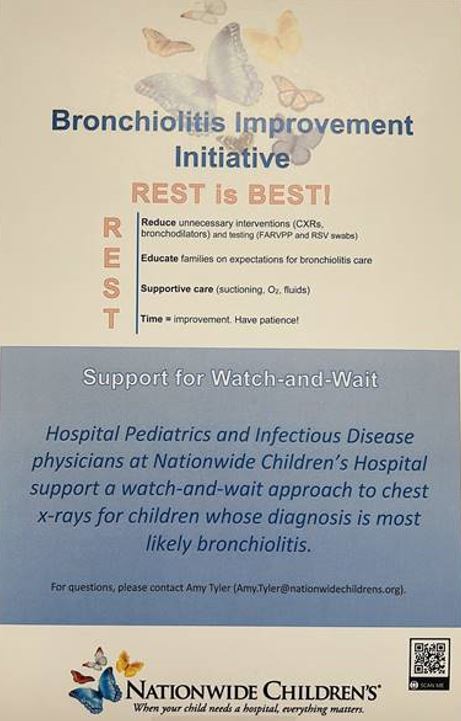Emergency Medicine 8
Session: Emergency Medicine 8
117 - Overcoming Barriers to Chest X-ray De-implementation in Bronchiolitis: An Emergency Department Quality Improvement Initiative within the ROUTT-B Study.
Sunday, April 27, 2025
8:30am - 10:45am HST
Publication Number: 117.6028
Gregory Stewart, Nationwide Childrens Hospital, Columbus, OH, United States; Rachel L. Thompson, Nationwide Children's Hospital, Columbus, OH, United States; Maya S. Iyer, Nationwide Children's Hospital, Columbus, OH, United States; Laura Rust, Nationwide Children's Hospital, Columbus, OH, United States; Amy Tyler, Nationwide Children's Hospital, Plain City, OH, United States

Greg Stewart, MD
Associate Professor of Pediatric Emergency Medicine
Nationwide Childrens Hospital
Columbus, Ohio, United States
Presenting Author(s)
Background: The American Academy of Pediatrics does not recommend the routine ordering of chest x-rays (CXRs) for patients presenting with bronchiolitis. Through a multidisciplinary implementation science (IS) project, Reduce Overutilized Tests and Treatment in Bronchiolitis (ROUTT-B), we discovered that CXRs were primarily being ordered in the Emergency Department (ED) due to perceived institutional barriers.
Objective: A department-specific quality improvement (QI) project was developed to focus on adapting several ROUTT-B strategies within the context of the ED and developing unique interventions to address ED-specific barriers to de-implementation.
Design/Methods: Understanding of institutional perceptions of CXR overuse discovered in the ROUTT-B de-implementation project was utilized to advance collaboration with inpatient services (Hospital Pediatrics and Infectious Diseases) and develop cultural alignment of expectations. Personal performance feedback allowed for identification of why variation in practices between high/low performers exist with subsequent departmental education to overcome these variances. Recognized departmental habits were further overcome using enhanced decision support within the electronic health record.
Results: From June 2019 to May 2020, 37% of admitted patients with bronchiolitis had a CXR ordered somewhere within the institution, with 64% of those performed in the ED setting. Further analysis revealed that 38% of patients admitted from the ED with bronchiolitis had a CXR before being transferred to the inpatient unit. After the interventions, the ED specific baseline demonstrated a centerline shift down to 26%, with the overall percent of admitted patients receiving a CXR shifting down to 29%.
Conclusion(s): Department-led QI projects can help to advance progress of multidisciplinary IS projects. Utilizing the lessons learned from the multi-institutional and multi-departmental ROUTT-B de-implementation project, a focused emergency department QI project further decreased the use of CXR in the ED.
Emergency Department CXR Ordered on Bronchiolitis Patients
 Emergency Department adaption of ROUTT-B strategies and department specific strategies reduced the rate of CXR in the ED from 38% to 26%.
Emergency Department adaption of ROUTT-B strategies and department specific strategies reduced the rate of CXR in the ED from 38% to 26%.Inpatient Pledge to Support
 This Pledge to Support was signed by Hospital Pediatrics and Infectious Diseases Faculty stating they support the ED in following the AAP guidelines regarding Chest X-Rays in patients with the primary diagnosis of bronchiolitis. ED decrease in CXR ordering did not lead to a supplemental increase in inpatient CXR ordering.
This Pledge to Support was signed by Hospital Pediatrics and Infectious Diseases Faculty stating they support the ED in following the AAP guidelines regarding Chest X-Rays in patients with the primary diagnosis of bronchiolitis. ED decrease in CXR ordering did not lead to a supplemental increase in inpatient CXR ordering.% Hospitalized Patients with Bronchiolitis Treated with Chest X-Rays
.jpg) After implementation of an ED QI project to adapt ROUTT-B strategies, a decrease of CXR ordering for bronchiolitis was seen from 37% baseline to 29%.
After implementation of an ED QI project to adapt ROUTT-B strategies, a decrease of CXR ordering for bronchiolitis was seen from 37% baseline to 29%.

